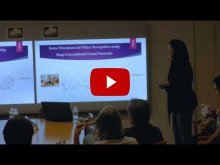 December 1, 2017 - 4:00 pm to 5:30 pm
December 1, 2017 - 4:00 pm to 5:30 pm Akram Bayat (UMass Boston, Visual Attention Lab)
Wei Ding (UMass Boston, Knowledge Discovery Lab)
Host: Mandana Sassanfar
Akram Bayat: From Motor Control to Scene Perception: Using Machine Learning to Study Human Behavior and Cognition
Abstract:
In this presentation, as part of my work at UMass Boston, two dimensions of implementing machine learning algorithms for solving two important real world problems are discussed. In the first part, we model human eye movements in order to identify different individuals during reading activity. As an important part of our pattern recognition process we extract multiple low-level features in the scan path including fixation features, saccadic features, pupillary response features, and spatial reading features.
While capturing eye movement during reading is desirable because it is a very common task, the text content influences the reading process, making it very challenging to obtain invariant features from eye-movement data. We address this issue with a novel idea for a user identification algorithm that benefits from extracting high level features that combines eye movements with syntactic and semantic word relationships in a text. The promising results of our identification method make eye-movement based identification an excellent approach for various applications such as personalized user interfaces.
The second part of my work focuses on scene perception and object recognition using deep convolutional neural networks. We investigate to which extent computer vision based systems for scene classification and object recognition resemble human mechanisms for scene perception. Employing global properties for scene classification, scene grammar, and top-down control of visual attention for object detection are three methodologies which we evaluate in humans and deep convolutional networks. We also evaluate the performance of deep object recognition networks (e.g., Faster R-CNN) under various conditions of image filtering in the frequency domain and compare it with the human visual system in terms of internal representation. We then show that fine-tuning the Faster-RCNN to filtered data improves network performance over a range of spatial frequencies.
Wei Ding: REND: A Reinforced Network-Based Model for Clustering Sparse Data with Application to Cancer Subtype Discovery
Abstract:
We will discuss a new algorithm, called Reinforced Network-Based Model for Clustering Sparse Data (REND), for finding unknown groups of similar data objects in sparse and largely non-overlapping feature space where a network structure among features can be observed. REND is an autoencoder neural network alternative to non-negative matrix factorization (NMF). NMF has made significant advancements in various clustering tasks with great practical success. The use of neural networks over NMF allows the implementation of non-negative model variants with multi-layered, arbitrarily non-linear structures, which is much needed to handle nonlinearity in complex real data. However, standard neural networks cannot achieve its full potential when data is sparse and the sample size is hundreds of orders of magnitude smaller than the dimension of the feature space. To address these issues, we present a model consisting of integrated layers of reinforced network smoothing and an sparse autoencoder. The architecture of hidden layers incorporates existing network dependency in the feature space. The reinforced network layers smooth sparse data over the network structure. Most importantly, through backpropagation, the weights of the reinforced smoothing layers are simultaneously constrained by the remaining sparse autoencoder layers that set the target values to be equal to the inputs. Our approach integrates physically meaningful feature dependencies into model design and efficiently clusters sparse data through integrated smoothing and sparse autoencoder learning. Empirical results demonstrate that REND achieves improved accuracy and render physically meaningful clustering results.
Speaker Bio:
Wei Ding received her Ph.D. degree in Computer Science from the University of Houston in 2008. She is an Associate Professor of Computer Science at the University of Massachusetts Boston. Her research interests include data mining, machine learning, artificial intelligence, computational semantics, and with applications to health sciences, astronomy, geosciences, and environmental sciences. She has published more than 122 referred research papers, 1 book, and has 2 patents. She is an Associate Editor of the ACM Transaction on Knowledge Discovery from Data (TKDD), Knowledge and Information Systems (KAIS) and an editorial board member of the Journal of Information System Education (JISE), the Journal of Big Data, and the Social Network Analysis and Mining Journal. Her research projects are sponsored by NSF, NIH, NASA, and DOE. She is an IEEE senior member and an ACM senior member.


